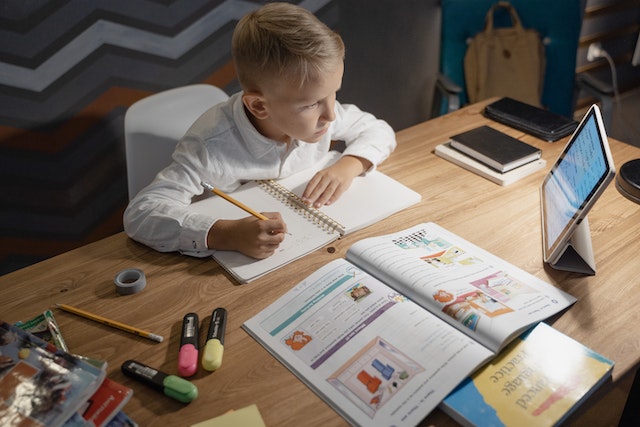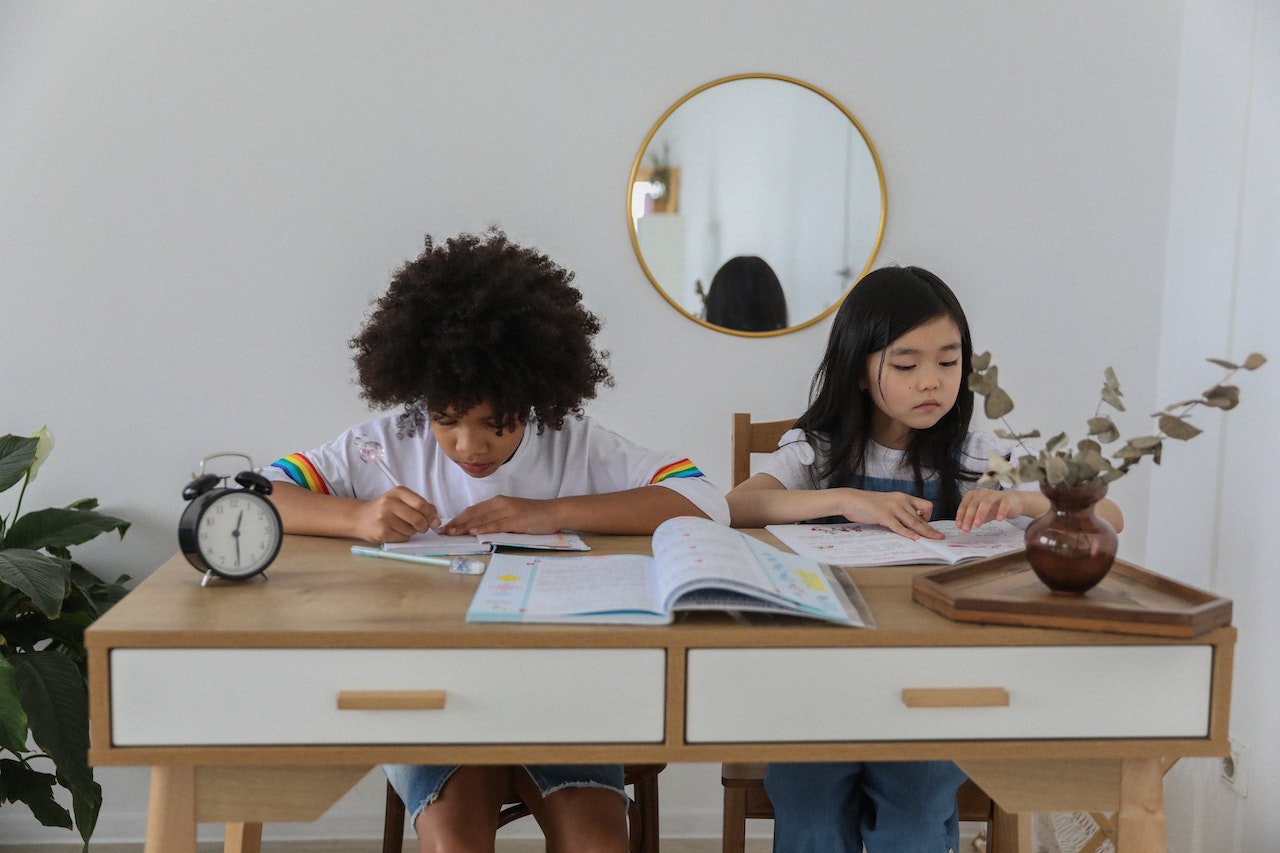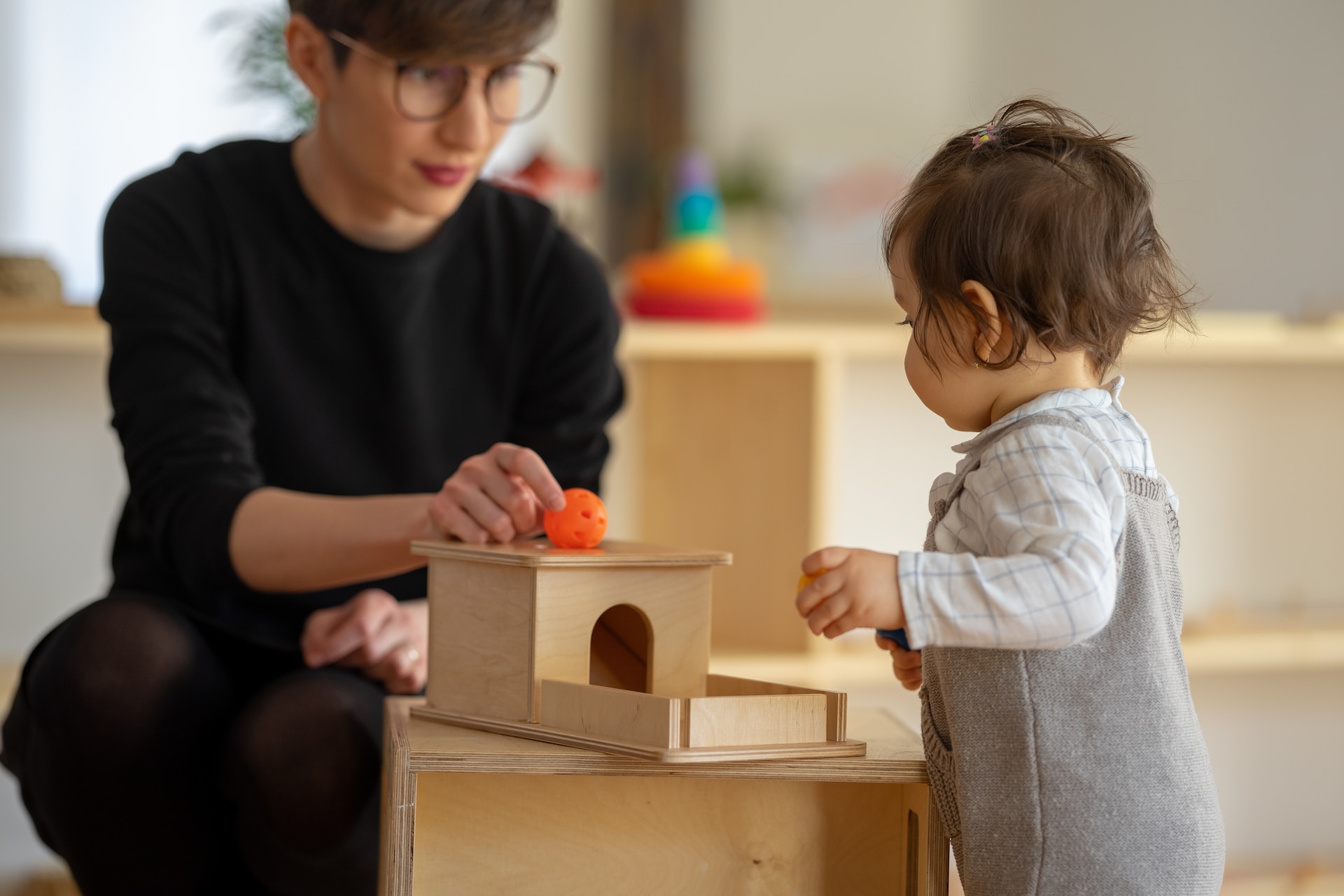Did you know homeschooling is becoming popular for many families today? According to the National Home Education Research Institute (NHERI), more parents teach their children at home instead of sending them to traditional schools. In the school year 2021 – 2022, 3.1 million children in grades K-12 were being homeschooled. Parents opt for homeschooling as it offers many benefits for children and their families. They can customize the curriculum to meet their child’s needs and foster personalized learning experiences.
However, it is crucial to prioritize children’s safety within their learning and recreational environments. Traditional schools often have established safety measures and protocols to keep children safe. For homeschooling, parents are responsible for creating that protective space within their homes. This includes physical well-being and online safety.
Additionally, it is important that children have plenty of opportunities for recreation and play within their safe environment. Engaging in physical activities, socializing with peers, and exploring creative outlets are essential for a child’s development and education. This article will provide important tips for creating an effective and safe learning space.
Safe environment
When homeschooling, creating a designated learning space within your home is crucial for fostering a productive and focused environment. The basics of an adequate space are:
- Having sufficient room for tables and desks
- Organizing materials and resources for easy access and safety
- Having sufficient lighting and comfortable seating
- Minimalizing distractions
Moreover, implementing home security measures will help protect you and your kids against potential threats, both online and offline. Some home security measures are locks, alarms, and surveillance systems; these will ensure the family’s physical safety. Parents and students can maintain internet safety through strong passwords, parental controls, and educating children about online risks.
What are some considerations for parents regarding natural lighting, noise levels, and overall comfort when selecting a location for homeschooling?
“When deciding where to set up your homeschooling space, it’s important to consider the needs of your child or children. Do they have sensory issues? Are they easily distracted? Do they work better individually or collaboratively?
Choosing a room with ample natural lighting can help with both focus and mood for most children. South-facing windows will provide the most daylight, so they are best, but even the best-positioned rooms will sometimes need additional light sources. Experimenting with artificial light temperature will give you a better idea of what environment works best for your child.
Most will have an easier time concentrating when they are removed from the distractions of the household. Choosing a room that minimizes external noise sources like busy streets or loud appliances will help your homeschool space be a place for focus. Other things to consider when looking for a quiet space in the home are soft surfaces that absorb sound (curtains, carpet, upholstered furniture, and rugs) or even noise-canceling headphones if necessary.
Overall comfort is perhaps the most important element for sustained engagement. Choose a room that can accommodate comfortable seating and workspace with proper ergonomic support. Constant shifting in a seat may be a sign of discomfort. Don’t forget to account for ample storage space in your area as well. Keeping the learning area organized and free from clutter will reduce visual distraction.”
Jordan Novak from Royal Fireworks Press
What are recommended guidelines for homeschooling parents to set up a designated study area with necessary supplies and materials?
“Having a designated area in your house for all your school supplies is a wonderful way to stay organized and consistent with schoolwork.
In our house, we have a large bookcase full of our curriculum, folders, binders, and paper. On top of the bookcase, we keep two school supply organizers that hold all of the pencils, erasers, scissors, glue sticks, markers, crayons, etc.
Having a “home” for all of those things means that we can find them quickly and get going with our school day, but it doesn’t mean we always stay in that room. My oldest kid likes to take her books to her room for peace and quiet while she works. While my middle child needs to stay right by me to keep on task, so we stay in the designated school area. The youngest likes to gravitate between the school area, living room, and her bedroom. And that works great for her!
But at the end of the day, all the school supplies, books, and binders come back to the school area. That way, they’re ready to go for the following day.
So, definitely have a special place in your home where you keep your school items and teach your children, but be flexible about spreading out around the house if that’s what works best for your child’s learning.”
Lauren from The Simple Homeschooler
How can parents optimize their existing living space to create an effective and conducive environment for homeschooling?
“Creating a homeschool space is a fun and exciting part of working in partnership with your child. Take the time to ask your child, or children, to make a wish list and draw what their learning space should look like. This will give you a wonderful insight into their ideas of how they see their role in learning.
Dr. Charlotte Immenschuh from K12 Loop
What are some factors parents should consider when choosing a suitable and safe location for homeschooling their children?
“When creating a learning space for your children, make sure their creative supplies are within their reach. We find that children often gravitate toward the school table when their supplies are easily accessible. Keep the school space full of intrigue. Hang fascinating maps on the walls, search for curiosities to display on a shelf, and rotate books and other invitations to learn, such as puzzles or games for children to stumble upon and explore.
Above all, remember that this is a space for them to feel entirely secure being their true selves and exploring where their curiosity takes them. An inviting space will come to life not necessarily due to a perfectly pristine and aesthetic space but by the inviting feeling of a blank canvas of discovery!”
Danielle Hansen from Harbor + Sprout
What are the key elements to consider when designing a physical space at home that supports successful homeschooling?
“When designing a space for homeschooling, think about the way your children learn best. Most children need a quiet space without distractions, so that’s always the #1 area of focus, but after that, you should consider if your child(ren) is a visual learner, auditory (or aural) learner, kinesthetic (or hands-on) learner, or reading and writing learner. This is important because it helps you focus on the space you’re creating for your children. For example, hands-on learners may need lots of table space in the room to do hands-on activities, whereas reading/writing learners might need comfy chairs in the corner and a small writing desk. Visual learners might need a TV or screen somewhere in the room you’re designing for your homeschool classroom.
The great thing about homeschooling is that it can be done anywhere. Outside, Inside, on the road, at a park, and anywhere in between. Learning happens all the time, and any place in your home can be utilized for homeschooling. Even if you don’t have a dedicated room, the kitchen table is also a fine place to enjoy learning with your kids. Remember to enjoy the journey with your kids no matter how you design your homeschooling space.”
Katie Avery from How To Homeschool
What are some space-saving ideas or multi-functional furniture options that work well in a homeschooling setting?
“From experience with my own kids, I find they thrive in a tidy and organized environment, and I truly believe that yours will too. Furniture layout is definitely one of the key ways that can make any room feel spacious or small. Ensure you have the correct spacing through walkway areas (at least ~36 inches), and this in itself will make a big difference!
When designing a homeschool-specific space, think about making good use of open and closed storage. Closed storage for messy supplies and open storage for inspirational supplies or things you use daily. Any furniture piece that can do double duty is great too. Make the most of any vertical space that you can, such as a cabinet that can be hung higher on the wall or a big cabinet that can handle books and art supplies.
I also love incorporating multi-use furniture items throughout the home so that kids have a chance to change their environment throughout their day. One of my favorites is to incorporate a coffee table with storage so that you can pop games, toys, or blankets away easily while still keeping them close enough so they are ready to use at any time.”
Melissa from Winter Daisy
How can parents foster a culture of safety awareness and responsible behavior in their children during Montessori homeschooling?
“To ensure safety awareness and responsible behavior in the home environment, Montessori has these recommendations:
- Create a prepared environment that encourages order, independence, and self-motivation. This means having a place for everything on a child-friendly scale and simplifying the home by limiting toy choices and keeping extra items in storage. This helps children develop competence in caring for themselves and their surroundings, as well as respect for the materials they use.
- Involve children in practical life activities that teach them how to perform everyday tasks safely and efficiently. For example, children can learn how to use kitchen tools, wash dishes, do laundry, or garden with adult supervision and guidance. These activities not only foster self-reliance and confidence but also provide opportunities for learning about natural consequences, problem-solving, and cooperation.
- Model safety awareness and responsible behavior by setting clear expectations and boundaries, communicating respectfully, and providing positive feedback. They can also encourage their children to explore their interests and passions while being mindful of the risks and benefits involved. For instance, parents can support their children’s curiosity about science or art by providing them with appropriate resources and materials but also teaching them how to handle them safely and responsibly.
By following these suggestions, parents create a Montessori homeschool environment that nurtures safety awareness and responsible behavior in their children while also fostering their creativity and curiosity.”
Larry Shiller from ShillerLearning
How can parents balance providing a safe environment while still encouraging independence and exploration during recreational activities?
“As a working homeschool mom, we want our kids to make friends and enjoy recreational activities but keeping them safe while doing this can be tough. Here are a few tips that I have found helpful with my children:
- Thoroughly research the activity beforehand. Find out who will be present, whether there will be adequate adult supervision, and if the individuals in charge can be trusted. Consider the child-to-adult ratio to ensure proper supervision. Additionally, familiarize yourself with the location to ensure it’s safe and suitable for your child. This is especially important if you need to drop them off on your way to work.
- Open communication is key. Establish clear rules and guidelines that prioritize your child’s safety while still allowing them to enjoy their freedom. Ensure that they know how to reach you in case of an emergency or if they feel unsafe. Teach them basic safety precautions such as wearing protective gear, looking both ways before crossing the street, and properly using equipment. Consistently reinforce these lessons to instill good habits.
- Remember that independence is cultivated over time. Start with small steps and gradually increase their responsibility and freedom as they gain confidence and experience. Encourage them to make decisions within the boundaries you’ve set, allowing them to explore and learn from their experiences.”
Jen from Practical, By Default
How can parents foster open communication with their children to ensure they feel comfortable reporting any safety concerns that arise during homeschooling?
“Open communication with children is essential for building strong relationships, promoting emotional well-being, and helping them develop healthy coping mechanisms. For homeschooling parents, open communication is especially important because, in addition to their parental role, homeschoolers oversee their child’s education. It is important that children feel comfortable reporting safety concerns that arise during homeschooling to their parent-teacher.
Fostering open communication starts with being a good listener to your child. Make it clear you are there to listen, and then really listen. Don’t interrupt. Don’t judge, even if you do not agree with how your child handled a situation. Next, ask them how they want to handle the situation. This can be a delicate balance as they work to find a solution. In the case where there are safety concerns, you will need to decide the most effective way to deal with the situation, even if your child disagrees with the solution. If this happens, you can maintain open communication by explaining to your child that it works two ways. Ask that they listen to you as you explain how you are going to handle the situation and why you are choosing to handle it that way.”
Blair Lee from SEA Homeschoolers
How can parents manage and prioritize their time effectively to stay organized and on track with homeschooling?
“There is no one way to effectively manage time, especially when keeping kids on track with homeschooling while perhaps managing your own work and personal life. But here are some suggestions:
First of all, preparation is key, says Robyn Parets, founder of Pretzel Kids®, a one-stop shop offering yoga, mindfulness, and social-emotional learning (SEL) programs for organizations and families.
“One of the best ways to prepare for a busy homeschooling day is to start the night before. For example, you can plan and prepare lunches in the evenings. You can also save time by meal prepping on the weekends for both weekday breakfasts and lunches,” says Parets.
“Preparing for meals isn’t the only way to save time on homeschooling days. You can also print out assignments, charge laptops and pick out clothing for the kids on the night before each school day.”
Secondly, establishing a daily routine is a great idea, she says. “This way, the homeschooling day will move along as the children get used to the structure of each day. For example, if chores are a part of your family’s day, perhaps the kids can tackle their academics in the early morning, then spend an hour doing chores, then go back to school work. After lunch, perhaps you build in time for extracurriculars like sports, music, or yoga. A daily routine will also help you manage everybody’s time, including your own!”
Robyn Parets from Pretzel Kids®
Homeschooling ideas
Consider incorporating kids’ activities to create a dynamic learning environment for your student. Through STEM projects, virtual visits, and leveraging technology, you can enrich your child’s educational experience while having fun.
- STEM projects: Integrating STEM (Science, Technology, Engineering, and Mathematics) projects into your homeschooling curriculum helps to develop children’s critical thinking skills. For example, you can explore physics concepts by building a homemade catapult or dive into biology by conducting plant growth experiments. You can find tons of STEM project ideas and resources on online platforms.
- Virtual visits: Take advantage of virtual visits to museums, art galleries, historical landmarks, and scientific institutions worldwide without leaving your home. Many renowned institutions provide virtual tours and interactive exhibits that allow children to explore and learn from the comfort of their homes.
- Technology: With technology, you open up a world of possibilities. Educational apps, online learning platforms, and interactive resources cater to different subjects and age groups. For instance, online platforms that provide interactive math lessons, language learning programs, coding tutorials, and virtual science labs. You can use video conferencing tools to connect with other homeschooling families, participate in online group discussions, or even arrange virtual field trips where children can collaborate and learn together.
How can parents ensure that STEM activities at home are conducted in a safe and supervised manner?
“When it comes to ensuring that STEM activities at home are conducted in a safe and supervised manner, parents can take a few important steps. Firstly, it’s crucial to research and plan ahead. Take the time to understand the project or experiment, including the materials, tools, and potential risks involved. Select activities that are age-appropriate and align with your child’s interests and abilities. As you dive into the activity, carefully read and follow the instructions provided in books, websites, or kits. Pay close attention to safety precautions, recommended age ranges, and any warnings or cautions mentioned.
Preparing the workspace is also essential. Create a designated area that is clean, well-lit, and well-ventilated. Remove any potential hazards or breakable items from the workspace, ensuring a safe environment for your child. Before starting the activity, gather all the necessary materials and tools so you have everything readily available.
To ensure supervision, always be present during STEM activities, especially when there are potentially dangerous materials or tools involved. Stay actively engaged, answer your child’s questions, and guide them through the process. Keep a watchful eye on their progress and intervene if you notice any unsafe practices.
Use age-appropriate materials and equipment to ensure your child’s safety. Avoid using small parts or sharp objects that could pose a choking or injury risk. If needed, consider child-friendly alternatives or use safety equipment like goggles or gloves.
In addition to supervision, teach your child about safety practices. Explain the importance of following instructions, using tools correctly, and handling materials responsibly. Encourage them to ask questions and seek help if they are unsure about anything. By providing a safe and supervised environment, parents can foster a love for STEM while keeping their children protected.”
Jess Brooks from Hess UnAcademy
How can parents ensure that the materials and tools used in Montessori activities are safe and age-appropriate for their children?
“Montessori, as an educational approach and way of life, recognizes the fact that every child is unique and capable. The goal is to meet them where they are at. Through observation of the child and listening to what they have to say, parents and caregivers can create prepared environments that are beautiful, organized in a way that supports the rhythms and routines of the child and family, and provide freedom within limits. Identifying what a child’s interests are, listening to their feelings, and knowing what they are able to do will all be important factors in determining what materials are appropriate for them. When parents and caregivers are working closely with children on a regular basis, it is a natural fit for those adults to be the ones observing and selecting materials for the children. By following the child, we can nurture their interests, model appropriate behaviors, and offer encouragement as needed, with the understanding that a certain amount of choice and risk actually supports their growth and autonomy. Using this approach instills intrinsic motivation and creates lifelong learners. Most importantly, it demonstrates a deep respect for the child.”
Kristin Tanner from Happy Homeschool Adventures
How can parents strike a balance between homeschooling activities and playtime to ensure their child’s overall development and well-being?
“Every child is different, but the best way to strike a balance between homeschooling activities and playtime is to set clear goals, develop a loose structure, and follow your child’s interests and passions. Academic goals will vary by child and age level but might be something like completing one math lesson, one reading lesson, one writing lesson, and one science or history lesson each day. Your daily schedule might include core academic work in the morning, a break for lunch and outside play, then extracurriculars, field trips, social groups, or passion projects.
The best way to ensure your child is invested in and excited about learning is to involve them in the process. Interdisciplinary learning through hands-on projects like designing an invention inspired by biomimicry, researching needs in your community and participating in service learning, or remixing inspirations to create something new can help your child to develop both core academic skills and life skills like goal setting and project management, reflection, entrepreneurship, and presentation skills.
Outside providers, like the engaging virtual program Prisma, can provide your child with a caring and experienced learning coach, supportive peer community, interactive live classes, and project-based curriculum that can spark your child’s love of learning.”
Kristen Shroff from Prisma
What are some examples of hands-on STEM projects or experiments that can be easily implemented at home?
“A fun STEM project is coding your own game in Scratch. Scratch is a free block-coding platform that runs in your browser. Kids can use drag-and-drop code to customize their own games and share them with kids around the world. There’s no setup; start building your game right away!
To start building a game, kids can follow a Scratch tutorial, remix a game that already exists, or just experiment on their own. If kids need inspiration, they can see hundreds of games in Scratch projects or simply replicate an existing game. For example, kids should try coding a tic-tac-toe game in Scratch.
There are also unplugged coding activities that kids can do at home. These free worksheets use games and puzzles to learn about coding concepts like algorithms, ASCII codes, and bubble sorting. These are a good introduction to metacognition, problem-solving, and abstract thinking. You can also find additional worksheets for specific languages, topics, and ages.”
Margaret Choi from CodeWizardsHQ
What are some effective ways to incorporate STEM activities into a homeschooling curriculum?
“Incorporating STEM activities into a homeschooling curriculum can be highly beneficial, enhancing creativity, critical thinking, and problem-solving skills. Here are some easy ways to incorporate STEM into your homeschooling routine:
- Hands-On Experiments: Convert theory into practice through engaging experiments. For science, try a DIY lava lamp or a homemade microscope. For engineering, building simple structures using straws, popsicle sticks, or LEGO blocks can be both fun and educational. STEAMsational.com offers 100s of free STEM activity ideas.
- Technology Incorporation: Utilize online resources to enhance learning. Websites like Code.org offer free, age-appropriate coding classes. Experiment with 3D design using tools like Tinkercad.
- Real-World Applications: Connect STEM concepts to real-life situations. Gardening can teach biology and ecology, baking can help understand chemistry and fractions, and budgeting or grocery shopping can provide practical math lessons.
- Project-Based Learning: Encourage in-depth exploration of STEM topics with long-term projects. For example, build a small robot, conduct a local environmental study, or design a city map.
- STEM Books and Kits: Utilize STEM-focused books and educational kits. The Mason Jar Scientist offers over 20 STEAM projects that are easy to do at home during your homeschool day, and you can find STEM kits on many homeschool curriculum sites, including STEAMsational.com.
- Inquiry-Based Learning: Encourage questions and guide your child to find answers independently. Base your STEM activities around the topics that interest your children.
By integrating these STEM activities, homeschooling can be a rich, engaging, and comprehensive educational experience.”
Brenda MacArthur, founder at STEAMsational.com
What are some strategies for homeschooling parents to help their children develop social skills and navigate social interactions effectively?
“The key to developing social skills for your homeschooled child is to create a mix of educational, community service, and social settings that encourage interaction. Make sure they are exposed to a wide range of age groups and people from other backgrounds.
Ideas for social settings: Church gatherings, community events, playdates with other homeschool families, and extended family get-togethers offer the ability to interact with people of all ages. However, sports participation and dance lessons are usually grouped by similar ages. Both types of events enable your child to interact with others in a natural environment.
Educational settings include: Sunday school, homeschool co-ops, art lessons at the local library, or book clubs that give your child an educational focus and are generally with people their own age. This type of social setting with a purpose allows children to develop friendships with people with similar interests.
Organized Youth Organizations: Another option is to get your children involved with established youth organizations such as 4-H, Girl Scouts, Boy Scouts, Trail Life, Toastmasters, or Junior Achievement. These groups allow parents to attend meetings and even become volunteers.
Our children have all been involved in 4-H. This organization is usually thought of as an agricultural group; however, it offers so much more than “farming and animals.” Non-animal projects range from Rocketry, Scrapbooking, Cake Decorating, Art, and even Public Speaking. The age range is generally ages 9-18. 4-H does an excellent job of providing social, educational, and community service within each group.
Teach them social/emotional skills: Many children struggle with knowing how to interact. Model good social interactions, role-play in social settings, and teach etiquette and good manners. Children learn what they see, not what you say. Make sure they have social skills modeled for them.
Finally, the most important thing to remember is that children (and adults) often “say the wrong thing” while learning to navigate new social situations. This is to be expected and should not cause embarrassment or anxiety. The goal is to help your child develop social skills while having fun!”
Patty from A Mother’s Random Thoughts

Homeschooling offers many benefits for parents, including personalized learning and a strong parent-child relationship. Using technology, there are also opportunities for kids to socialize. However, parents must consider the critical aspect of ensuring a safe educational and recreational environment. Establishing a protective space that prioritizes physical safety, emotional well-being, and play opportunities creates an environment where children can thrive, explore, and reach their full potential.




